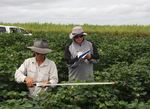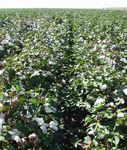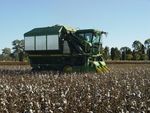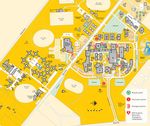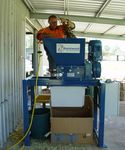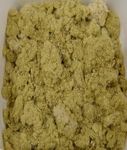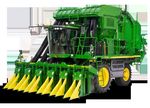Australian Cotton Research Conference - 2nd - 8-10 September 2015 - Association of Australian ...
←
→
Page content transcription
If your browser does not render page correctly, please read the page content below
2 Australian
nd
Cotton
Research
Conference
s e c u r i n g
Sc i e n c e t u r e
n s
’ f u
cotto
8-10 September 2015
University of Southern Queensland, Toowoomba
Australian Cotton Research Conference 2015 |iConference sponsors Disclaimer: The Association of Australian Cotton Scientists accepts no responsibility for the information or views presented in these proceedings. All copyright for this material presented remains with the original authors.
Australian Cotton Research
Conference
8-10 September 2015
University of Southern Queensland,
Toowoomba campus
Hosted by The Association of Australian Cotton Scientists
Promoting inquiry, networking and collaboration in the
Australian cotton research communityWelcome to delegates Dear Delegates, On behalf of the organising committee and the AACS I would like to welcome you to Toowoomba for the 2015 Australian Cotton Research Conference. In developing the conference theme “Science Securing Cotton’s Future”, the committee considered the purpose of the conference and how the diversity of disciplines contributes to the Australian Cotton Industry. Science has played a big part in securing the success of the Australian cotton industry, and the levies from a flourishing industry have ensured wide ranging scientific endeavour. Over the next three days we have a unique chance to present and discuss ideas, and consider what developments are likely to continue securing cotton’s future. I thank our foundation sponsor the Australian Cotton Research & Development Corporation. I also wish to acknowledge the support provided by Institute for Agriculture and the Environment of the University of Southern Queensland for providing such a great Conference venue. We are also grateful for the support and sponsorship provided by: CSIRO, CSD, Monsanto, QDAF, UWS, NSW DPI, and Australian Government. Thank you to the committee for all of their efforts in preparing for this conference. In particular I would also like to thank Tonia Grundy (QDAF) and Anna Stephenson & Liz Neary (USQ) who have done a lot of behind the scenes preparation for this event. Take the opportunity to get involved and make the most of the wide range of topics on offer. Best wishes, Paul Grundy (QDAF) (Conference Committee Chair) Other committee members: Kristy Byers (QDAF) Alison McCarthy (NCEA, USQ) Linda Smith (QDAF) Warren Conaty (CSIRO) Ruth Redfern (CRDC) Gupta Vadakattu (CSIRO) Kristen Knight (Monsanto) Brajesh Singh (UWS) Duncan Weir (QDAF) Dear Delegates, Welcome to our second cotton research conference. Firstly I would like to thank Paul and his team for their efforts in pulling together this important event for our association. Like many successful aspects of the industry we support, the continued need for our own open and frank discussions are important to move ideas forward in addressing the challenges we face. I strongly encourage your engagement in discussions around yours and others science; ‘be challenged and challenge’. The conference activities and invited speakers are in place to help this. Our Association aims to provide a united and representative body to promote and enhance cotton research as a profession; to facilitate communication and collaboration between scientists; and to act as a point of contact between scientists, the Australian cotton industry and with the International Cotton Researchers Association. Please consider membership and attending our Annual General Meeting on the last morning of the conference. We would welcome your involvement and any of your ideas where the association can pursue its objectives. Enjoy the conference. Yours sincerely, Mike Bange (AACS Chairperson)
Dear Delegates,
On behalf of the Institute for Agriculture and the Environment I extend a warm welcome to the
Toowoomba Campus of the University of Southern Queensland.
We are delighted to be a major sponsor of the 2015 Australian Cotton Research Conference. Our
current research collaborations are focused on automated irrigation and fertiliser application
systems, new weed control measures, on-farm energy efficiency, new harvest technologies, seasonal
productivity forecasting and undertaking studies to develop the cotton industry’s workforce.
For over 20 years USQ has been proud to play an important and continuing role in helping to build
a national community of research excellence in cotton research. I wish you all the very best for a
successful and informative conference.
Kind regards,
Professor Steven Raine
Executive Director, Institute for Agriculture and the Environment
University of Southern Queensland
Program summary
Tuesday 8 September Wednesday 9 September Thursday 10 September
7:30 Registration desk open 8:00 Tea & coffee 8:00 Tea & coffee
8:00 Tea & coffee (Registration desk open) (Registration desk open)
8:30 Housekeeping 8:30 Housekeeping 8:25 Housekeeping
8:40 AACS Welcome 8:40 Plenary 8:30 AACS AGM
Speakers - Iain Wilson,
9:00 Plenary 9:20 Plenary
Braj Singh
Speaker - Tim Deutsch Speaker - Gary Fitt
10:00-10:30 Morning tea 10:30-11:00 Morning tea 10:20-10:45 Morning tea
10:30 Session 1 11:00 Session 4 10:45 Session 6
Stream 1: Farming Systems Stream 1: Breeding Stream 1: Insect Resistance
Stream 2: Weed Science Stream 2: Nutrition Stream 2: Irrigation
Stream 3: Natural resources
12:30-1:30 Lunch 1:00-2:00 Lunch 12:45-1:30 Lunch
1:30 Session 2 2:00 Session 5 2:30 Session 7
Stream 1: Farming Systems & Stream 1: Pathology Stream 1: Fibre science
Plant Science Stream 2: Breeding Stream 2: Entomology
Stream 2: Entomology Stream 3: Social Science
Stream 3: Energy
3:00-3:30 Afternoon tea 3:30-4:00 Afternoon tea 3:30-4:00 Afternoon tea
3:30 Session3 4:00 Plenary 4:00 Plenary
Stream 1: Plant Science Student interaction Poster presentations
Stream 2: Carbon and climate Speaker - Paul Barnett
Closing comments
5:00-5:10 short break 5:00-5:10 short break 5:30 close
5:10-6:00 Devil’s advocate at USQ 5:10-6:00 Devil’s advocate at
refectory USQ refectory
6:15-8:00 Welcome function at 6:00 close 6:45-late Conference Dinner
USQ refectory Featuring the band Celestino
at Picnic PointContents
General information 1
Location 1
Parking 1
Transportation 1
Conference merchandise 2
Conference Wi-Fi 2
AGM 2
Social events 2
Welcoming Reception 2
Conference dinner 2
Devil’s advocate 2
Plenary speakers 3
Program
Tuesday 8 September 6
Wednesday 9 September 8
Thursday 10 September 10
Abstracts
Session 1
1. Plant, Soil & Systems 12
2. Weed Science 15
Session 2
1. Plant, Soil & Systems cont. 18
2. Applied Entomology 21
3. Energy 24
Session 3
1. Plant Science 26
2. Carbon and Climate 29
Session 4
1. Cotton Breeding 31
2. Cotton Nutrition 34
3. Natural Resource Management 37
Session 5
1. Cotton Pathology 41
2. Social Science & People 44
3. Cotton Breeding: Fibre 47
Plenary session (open to students) 49
Session 6
1. Insect Resistance Management 50
2. Irrigation Science 53
Session 7
1. Fibre Science and Processing 57
2. Entomology 59
Posters 61General information
Location
The 2015 Australian Cotton Research Conference is being hosted by the University of Southern
Queensland’s Institute for Agriculture and the Environment. The USQ Toowoomba campus on
West Street is host to over 4000 students studying Business, Communication, Creative Arts,
Health, Humanities, Education, Engineering and Spatial Science, Information Technology, Law, and
Agricultural Sciences. USQ is recognised for its research in agriculture and climate science applications,
regional development, and digital literacy and education.
Conference sessions
will be held in the
Allison Dickson
main lecture theatre
(Building H) and the
L206 and Q1 rooms
on campus. The
registration desk is
located in the foyer
of the Allison Dixon
Theatre.
Located about 125 km
west of Brisbane,
and the gateway to
Queensland’s Darling
Downs, Toowoomba is
a vibrant city of more
than 100,000 people.
With beautiful public
gardens, interesting
historical sites and
museums, and national
parks nearby, it is well
worth a visit. A larger campus map is available inside the back cover.
Find out more at www.southernqueenslandcountry.com.au/destinations/toowoomba/
Parking
Free parking for the conference is available in parking area 10.
Transportation
There are no motels within easy strolling distance of the venue.
Several urban routes service the university. Further information on routes and fares is available from
Bus Queensland (busqld.com.au), or the Queensland Government’s urban busses website (www.qld.
gov.au/transport/public/transport/timetables/qconnect/toowoomba/).
Several taxi companies operate in Toowomba. Those with 13 numbers include:
13 3222 Garden City Cabs (Black and White Taxi Service)
13 1008 Taxis Toowoomba
13 2227 Toowoomba Cab Company
13 1924 Yellow Cabs
Australian Cotton Research Conference 2015 |1Conference merchandise
Merchandise is embroidered with the 2015 conference logo.
Caps $17
Surf hats $25 (sizes S-XL)
Polo shirts $25 (Mens sizes S - 5XL | Women’s sizes 8 - 24)
Merchandise pre-ordered by 13 August will be available cor collection at the registration desk.
Additional postage costs may be applicable for orders after this date.
Conference Wi-Fi
The University of Southern Queensland is making Wi-Fi available for conference attendees. Connect to
the “USQ-Guest” (not Visitor) wireless access point and enter the following credentials:
Username: cotton
Password: Welcome123
AGM
The annual general meeting of the Association of Cotton Scientists will be held on Thursday morning
in the Allison Dickson lecture theatre. Please come along and support your association.
See the flyer in your conference pack for more details.
Social events
Entry to both of the offical events for the conference is included in a delegate’s registration fee
(excludes day registrations).
Welcoming Reception
Tuesday 8 September, 6:15-8:00 pm at the USQ refectory.
Come along to catch up with old friends, meet new ones, and relax. Finger foods and drinks are
included. The reception will follow on from Tuesday’s Devil’s Advocate session.
Conference dinner
Thursday 10 September, 6:45 pm-late at Picnic Point.
The conference’s concluding celebratory dinner will be a night of fun with great food and drinks,
awards (both serious and comical!) and live music from the band Celestino.
Picnic Point Toowoomba is one of Toowoomba’s premier locations for events. It is situated approx. 700
metres above sea level and has panoramic views of the range escarpment and the Lockyer Valley.
Dress: Smart casual
Devil’s advocate
Devil’s advocate sessions encourage delegates as a group to freely discuss points of interest.
The sessions start with some wine. The Devils will take it in turns to express an opinion (possibly
counter to their own) on an idea or theory from the day that is controversial or of interest. Delegates
are invited to counter this perspective and potentially highlight or challenge some of the ideas and
theories generated from talks during that day.
Sessions are managed by an adjudicator who will make sure that no delegate (or devil) talks for too
long or too often, and that everybody “plays the ball not the player”. At the end of the session the
adjudicator summarises the day’s events.
2 | Australian Cotton Research Conference 2015Plenary speakers
Timothy A. Deutsch
Global Director, Crop Harvesting Engineering (Retired)
John Deere Global Crop Harvesting Product Development Center, Illinois
Email: tadeutsch@windstream.net
Research and Development of the 7760 Cotton Picker!
Formerly a global director at the John Deere Global Crop Harvesting Product
Development Center, Tim Deutsch is currently farming in Newton, Iowa, where
he grows corn, soybeans, and hay and raises purebred Charolais cattle.
During his 36-year career, Tim played a significant role in the development of major cotton harvesting
equipment for both emerging and existing markets worldwide. His products have included cotton
pickers and cotton strippers produced for harvesting needs of cotton growers. He has been
instrumental in bringing to market various cotton picker models, many of which have received AE50
awards for outstanding production innovation. He designed advancements into these products
including the capability to harvest up to six rows (pickers) and nine rows (strippers) to increase
machine productivity; innovative changes to operator stations; and hydraulic and electrical systems
that have allowed further productivity and efficiency improvements. Through his guidance, these
product and feature developments have resulted in enhanced productivity for the cotton grower and
the cotton industry.
Tim Deutsch’s vision and understanding of the cotton industry led to one of his major
accomplishments, the development and introduction of the state-of-the-art 7760
Cotton Harvester that eliminated the conventional basket and replaced it with
a nonstop round module process. This machine increased the productivity
of cotton harvesting and reduced seasonal labour requirements, in
addition to preserving cotton quality and increasing productivity for
transporting, handling, and ginning. From 2001 to 2014, Tim had global
engineering product development responsibility for cotton and sugar
cane harvesting, as well as combines and front end equipment. He also
demonstrated outstanding leadership in developing the next generation
of innovative engineering leaders, through his mentoring of product development teams
and design engineers.
A 37-year member of ASABE, Tim has contributed to Power and Machinery committees, including PM-
23/7/3 Cotton Engineering and PM-50 Cotton Engineering. He has also provided expertise to various
safety and lighting standards committees. He has been an active member of the Iowa section and has
served on the membership committee and in helping to organize section meetings and tours. He is
the recipient of an Iowa Section Young Engineer of the Year award and Engineer of the Year award. Tim
was recognised in 2013 as one of John Deere’s top innovators as the recipient of 40 priority patents.
His other John Deere awards include a John Deere Chairman’s Innovation award for 7760 Cotton Picker
Project, John Deere Ag & Turf Division Presidents’ Award of Excellence, and a John Deere Innovation
Recognition - Board of Directors Technology Innovation Field Day award.
Tim Deutsch is the recipient of the ASABE 2015 Mayfield Cotton Engineering Award in recognition
of his leadership and engineering innovations toward advancing the cotton industry through
development of highly productive cotton harvesting machinery and new technology applications.
Other past professional membership activities include having served as a trustee of the National
Cotton Council, and as a member of the Cotton Foundation Research Screening committee. Tim
has served on the advisory boards of Iowa State University, Mechanical Engineering and Texas A&M
University Cotton Engineering departments.
A native of a farm near Dixon, Illinois, Tim is a graduate of the University of Illinois with a bachelor’s
degree in Agricultural Engineering.
Australian Cotton Research Conference 2015 |3Dr Gary Fitt
Science Director,
CSIRO Biosecurity Flagship
Ecosciences Precinct
41 Boggo Road, Dutton Park, Brisbane
Email: gary.fitt@csiro.au
From grubs to Ebola: reflections on the ecological underpinning of pest
management, resistance management and biosecurity
Gary Fitt obtained his PhD from the University of Sydney and joined CSIRO as an Experimental
Scientist in 1977. During a 20 year career at the Australian Cotton Research Institute at Narrabri, NSW,
he advanced to the level of Senior Principal Research Scientist before becoming the Chief Executive
Officer of the Australian Cotton Cooperative Research Centre (CRC) in 1999, also based at Narrabri. In
2004 he became the Deputy Chief of CSIRO Entomology, and relocated to Brisbane, then Deputy Chief
of CSIRO Ecosystem Sciences, the position he held until the establishment of the Biosecurity Flagship
in 2012, where he is Science Director.
Gary has extensive research experience in agricultural sustainability with a focus on integrated pest
management systems particularly in the development and deployment of transgenic cottons and the
resistance management systems required to sustain this technology. His specific expertise is with the
ecology, movements and resistance evolution of the Helicoverpa moth, one of the most damaging
pests of Australian and global agriculture. In the Biosecurity Flagship he has broadened applications to
address the wider biosecurity risks to Australia’s people, industries and environment.
He has published more than 100 refereed publications, and contributed to more than 20 books.
He has held many other positions, including Board Director of the Cotton Catchment Communities
CRC, Chair of an expert panel for the International Cotton Advisory Committee, Member Advisory
Committee for the Australian India Strategic Research Fund and is currently Chair of the Science
Advisory Body of the OECD Cooperative Research Program in Sustainable Agriculture. He is an Adjunct
Professor at both the University of New England and the University of Sydney.
Dr Iain Wilson
Team Leader | Cotton Disease Markers
CSIRO Agriculture Flagship
Black Mountain Laboratories
Clunies Ross Street, Canberra
Email: iain.wilson@csiro.au
A Molly Bolly’s guide to Cotton
Iain Wilson did his PhD on bacterial gene regulation at Melbourne University. His post-doctoral
research was at the Department of Plant Biology, Carnegie Institution of Washington Stanford,
investigating powdery mildew disease resistance in model plant Arabidopsis. During this period he
was one of the first to apply microarray technology to survey gene expression in infected plants. In
1999 he joined Plant Industry and established a microarray facility where he collaborated in a wide
range of research.
Iain’s initial foray into cotton research was understanding the molecular basis for waterlogging
tolerance in 2005. From 2009 onwards his has lead a team developing molecular markers to assist
CSIRO cotton breeders enhance disease resistance in commercial varieties to a range of pathogens
that are important to the Australian cotton industry.
4 | Australian Cotton Research Conference 2015Prof Brajesh Singh
Centre Director
Global Centre for Land-Based Innovation
Hawkesbury Institute for the Environment, University of Western Sydney
Bourke Street, Richmond
Email: b.singh@uws.edu.au
Integrating soil health and management strategies to enhance farm
productivity and sustainability
Brajesh Singh completed his PhD on the interaction of pesticides with soil biology, at Imperial College,
London in 2003. Some publications from these studies are listed as the most cited research within
the discipline. He joined Macaulay Land Use Research Institute, Aberdeen (UK) in 2002 and was a
Principal investigator on two national projects on soil health that led to the development of base-line
indicators for soil health evaluation and monitoring at a national level. Braj is a well-known expert in
crop-microbial interaction on roots and how this can be harnessed to increase farm productivity and
adaptation of crops to extreme events and climate change.
In 2012 he became Theme Leader of Soil Biology and Genomics at the prestigious Hawkesbury
Institute for the Environment. He has led/ co-led a number of national and international initiatives
since then including the establishment of the Global Centre for Land-Based Innovation, Global
Soil Biodiversity Steering Committee and the Global Soil Biodiversity Atlas. He serves on steering
committees of two EU initiatives including one on pesticide impact of soil health and dryland
ecosystems, currently serves on the editorial boards of six international journals, including as a senior
editor, and holds honorary positions in the UK and China.
Braj’s research is at the forefront of discovering the mechanisms and consequences of land use change
and management practices on soil health and productivity. In particular, his research is providing key
information about the link between soil health and ecosystem functions, including farm productivity,
nutrient cycling, soil fertility and greenhouse gas emissions.
Paul Barnett
Managing Director
Impact Freelancer
Email: paul.b@rnett.co
Innovation pathways; from R&D to commercialisation
Paul is a freelance research management consultant providing advice to the
innovation sector on strategy development, improved execution of plans and
acceleration in delivery of impacts. Paul has also held senior positions in CSIRO
where he was responsible for areas that included strategy development, partnering, knowledge
brokering and business models. In Paul’s career he has performed in a diverse set of roles including in
government, corporate commercial and start-ups.
In 2014 for the Cotton Research and Development Corporation, Paul designed and delivered a creative
process that identified 24 new concepts with the potential to add $4bn to the annual gross value of
Australian cotton production. The project drew on strengths of the cotton industry while integrating
a new set of knowledge and expertise that could help address the most important trends and
challenges.
The innovation sector has changed. There is a trend towards less funding for research and an
expectation from government, industry and communities that research is linked with net positive
impacts for society, economy and environment. Paul will share his experience and thinking on how
our ability to plan and clearly articulate pathways to our impacts is now critical to how we do research.
Australian Cotton Research Conference 2015 |5Full program - Tuesday 8 September
7:00 Registration desk open Allison Dickson Foyer
8:00 Coffee/Tea Allison Dickson Foyer
8:30 Housekeeping/Conference Purpose (Paul Grundy, AACS Conference Chair) Allison Dickson Theatre
8:40 AACS Welcome Dr Michael Bange AACS President and Professor Steven Raine,
Executive Director, Institute for Agriculture and the Environment, USQ
9:00 Plenary Session (Chair: Assoc. Prof. Craig Baillie USQ)
Mr Tim Deutsch, John Deere USA Research and Development of the 7760 Cotton Picker!
10:00-10:30 Morning tea Allison Dickson Foyer
SESSION 1
Stream 1: Plant, Soil & Systems (Chair: Diogenes Antille) Allison Dickson
10:30 Soil compaction and the John Deere 7760: side by side comparison of a controlled traffic
and standard picker John McLean Bennett
10:45 How much energy is required to overcome the soil compaction caused by the John Deere
7760 and what are the implications on yield? Troy Jensen
11:00 Defoliation timing and moisture draw down as end of season management to limit soil
compaction at pick Stirling Roberton
11:15 Irrigation induced runoff and carbon balance in a cotton farming system Gunasekhar Nachimuthu
11:30 Identifying microbial modulators of soil carbon storage under crop rotations in Cotton
producing agro-systems Pankaj Trivedi
11:45 Long-term changes in soil chemical properties of a Vertosol irrigated with tertiary treated
sewage effluent Nilantha Hulugalle
12:00 Composts addition may improve biology in cotton soils Gupta V.V.S.R
12:15 Effect of sodicity on mycorrhizal colonisation of cotton (Gossypium hirsutum L.) Samieh Eskandari
Stream 2: Weed Science (Chair: Ian Taylor) Room Q1
10:30 Discrimination of Herbicide Drift Damage in Cotton Crops under Varying Stages of Growth
and Chemical Dosages using Hyperspectral Sensor Armando Apan
10:45 BYGUM – a new tool for BarnYard Grass Understanding and Management David Thornby
11:00 Growth and development of three key summer grasses in Australian cotton systems Michelle Keenan
11:15 Genetics of glyphosate resistance James Hereward
11:30 Can patches of glyphosate-resistant Echinochloa colona be eradicated? Jeff Werth
11:45 15 years of Roundup Ready® cotton: Weed species shift on Australian cotton farms Meredith Conaty
12:00 Is Australia ready for triple gene herbicide stack technology? Sudheesh Manalil
12:15 Discussion
12:30-1:30 Lunch Allison Dickson Foyer
SESSION 2
Stream 1: Plant, Soil & Systems (Chair:Warren Conaty) Allison Dickson
1:30 Re-evaluating mepiquat chloride use in Bollgard II cotton Sandra Williams
1:45 Winter sowing for more reliable boll filling in Central Queensland Paul Grundy
2:00 Australian Cotton Systems in a ‘Climate of Change’ Michael Bange
2:15 Climate change impact on crop productivity: legacy effect through plant-soil feedback Yui Osanai
2:30 Chloride Mass Balance models are an economic method of assessing the effects of cotton
farming systems on deep drainage in Vertosols Tim Weaver
2:45 Thin oxodegradable film and profile soil water under cotton Michael Braunack
2:50 Irrigation induced deep drainage losses of soil carbon in a cotton farming system of Australia Mark Watkins
6 | Australian Cotton Research Conference 2015Stream 2: Applied Entomology (Chair: Kristen Knight) Room L206
1:30 Biology of Minute Two Spotted Ladybird Jamie Hopkinson
1:45 IPM reduces risks from Silverleaf Whitefly Lewis Wilson
2:00 Natural Mortality Helps to Mediate Silver Leaf Whitefly Development Tanya Smith
2:15 The “Zappa” trap: A potential Light trapping system for monitoring and controlling
Helicoverpa spp. and sucking pests in cotton crops Alison Young
2:30 UAVs to detect pest damage in broad acre crops: Insect Damage in Sorghum and
implications for cotton Eduard Puig
2:45 Establishing Southern Cotton – Thrips threshold validation Sandra McDougall
Stream 3: Energy (Chair: Jon Welsh) Room Q1
1:30 The feasibility of alternative energy sources in the Australian cotton industry Gary Sandell
1:45 Economic feasibility of using solar energy to reduce diesel consumption in off grid cotton
irrigation bores John Hill
2:00 An overview of energy auditing lessons from recent projects in the Australian cotton
industry Gary Sandell
2:15 A Pilot Study - Cotton Gin trash to Bioethanol Shane McIntosh
2:30 Cotton Gin waste Biofuel for Diesel Engine Saddam Al-lwayzy
2:45 Combustion of Cotton Seed Biodiesel in Diesel Engine Saddam Al-lwayzy
3:00-3:30 Afternoon tea Allison Dickson Foyer
SESSION 3
Stream 1: Plant Science (Chair: Warwick Stiller) Allison Dickson
3:30 Canopy Temperature during Cotton (Gossypium hirsutum L.) Fibre Development:
Associations with Fibre Quality Onoriode Coast
3:45 Understanding the photosynthetic biochemistry that underpins cotton photosynthesis
under future climate extremes. Robert Sharwood
4:00 Growth and yield dynamics of different canopy layers of cotton in response to soil
waterlogging Najeeb Ullah
4:15 What they do while you’re sleeping: Nocturnal transpiration in cotton Warren Conaty
4:30 Investigating the Mechanisms of Heat and Water Stress Resistance of Cotton Demi Gamble
4:45 The integrated effects of elevated CO2 and temperature on early-stage cotton growth and
physiology K. Broughton
Stream 2: Carbon & Climate (Chair: Mark Howden) Room L206
3:30 Intro Talk for Session Mark Howden
3:45 The impact of climate change on cotton in Australia Allyson Williams
4:00 Cradle to export-port greenhouse gas assessment of cotton production in north-west New
South Wales Paul (Mehdi) Hedayati
4:15 Positioning Australia for its Farming Future David Lamb
4:30 Determination of Emission Factors for Estimating Nitrous Oxide Emissions from Australia’s
Cotton Industry Clemens Scheer
4:45 Sustainability reporting for agriculture – an overview of available reporting metrics on
emissions Richard Eckard
5:00 Short break
5:10–6:00 Devil’s advocate (Discussion with a glass of wine) Student Refectory
6:15-8:00 Welcome Reception Student Refectory
Paul Grundy & Bruce Finney, CRDC
Nibbles and drinks
Australian Cotton Research Conference 2015 |7Full program - Wednesday 9 September
8:00 Coffee/Tea, Registration desk open Allison Dickson Foyer
8:30 Housekeeping (Paul Grundy, Conference Chair) Allison Dickson
8:40 Plenary Session (Chair: Dr Gupta Vadakattu, CSIRO)
Dr Iain Wilson, CSIRO A Molly Bolly’s guide to Cotton
Professor Braj Singh, UWS Integrating soil health and management strategies to enhance
farm productivity and sustainability
10:30-11:00 Morning tea Allison Dickson Foyer
SESSION 4
Stream 1: Cotton Breeding (Chair: James Quinn) Allison Dickson
11:00 Can breeding solve all our problems? Warwick Stiller
11:15 The yield potential of cotton (Gossypium hirsutum L) Greg Constable
11:30 Role of genotype × management synergies for cotton productivity Shiming Liu
11:45 Sources of host plant resistance to thrips in cotton Carlos Trapero
12:00 Development of an automated cotton plot picker for small scale trials Max Barnes
12:15 Usefulness of nondestructive technologies for phenotyping in breeding high yielding cotton Shiming Liu
12:30 Genome-Wide Association Studies: Hunting for Marker-Trait Associations in Plants Washy Gapare
12:45 Genomics enabled fast forward genetics in cotton Qian-Hao Zhu
Stream 2: Nutrition (Chair: Steve Yeates) Room L206
11:00 In crop nutrient management, “Are we there yet”? Chris Dowling
11:15 Application of Solvita test kit methodology to estimate soil N mineralisation Francois Visser
11:30 Can optimising nitrogen fertiliser rate mitigate nitrous oxide loss from flood-irrigated cotton
paddocks? Graeme Schwenke
11:45 Response of irrigated cotton to applied nitrogen John Smith
12:00 Optimising Water & Nitrogen Fertiliser Management in Australian Cotton Production
Systems Jon Baird
12:15 Opportunities for managing nutrient efficiency in cotton production Mark Pawsey
12:30 Fewer control plots for rate response trials Bruce McCorkell
12:45 Cotton root systems and recovery of applied P and K fertilisers David Lester
Stream 3: Natural Resource Management (Chair: Jane Trindall) Room Q1
11:00 Annual entitlement for the Condamine floodplain irrigators – is it really working? Elad Dafny
11:10 Recharge processes at the St George Irrigation Area Elad Dafny
11:20 The decline and rise of groundwater levels in the Maules Creek Catchment (Upper Namoi):
implications for water resource management Calvin Li
11:35 Detecting connectivity between an overlying aquifer and a coal seam gas resource using
methane isotopes, dissolved organic carbon and tritium. Charlotte Iverach
11:50 Quantifying the Potential Impact of Abandoned Exploration Wells on Groundwater Mark Hocking
12:05 Impulse Response Groundwater Model of Western Border Rivers Catchment Mukhlis Mah
12:10 Cotton soil salinity and nitrate profiles over 20 years of irrigation Alice Melland
12:15 How many trees are enough? Using vegetation to combat deep drainage and seepage Andrew Biggs
12:30 Carbon sequestration in riparian zones on cotton farms Rhiannon Smith
12:45 Governing Uncertainty: the cotton industry’s responses to resource uncertainty Olive Hood
1:00-2:00 Lunch Allison Dickson Foyer
8 | Australian Cotton Research Conference 2015SESSION 5
Stream 1: Pathology (Chair: Lily Pereg) Allison Dickson
2:00 The importance of cotton disease surveys in Queensland for monitoring endemic diseases
and detecting new pathogens and pests Linda Smith
2:15 What influences fungal communities in cotton soils Gupta V.V.S.R.
2:30 NSW DPI Biosecurity Update on Defoliating strain of Verticillium dahliae 1A Karen Kirkby
2:45 Efficacy of fungicide seed treatments on reducing seedling mortality in cotton in Australia Peter Lonergan
2:55 Mycorrhizal status in cotton following rice Joe Moore
3:10 Cotton leafroll dwarf virus detected in Thailand and Timor Leste Murray Sharman
3:15 Nematodes of the Gwydir and Namoi Oliver Knox
Stream 2: Social Science & People (Chair: Sandra Williams) Room Q1
2:00 Is it just for the money? What are the motivations of an Australian Cotton Grower Geraldine Wunsch
2:15 Integrated economic, environmental and social performance reporting of Australian
Grown Cotton Guy Roth
2:30 Adaptive learning pathways for cotton irrigation science Jane Trindall
2:45 CottonInfo Extending Research Lance Pendergast
3:00 Developing Education Capacity in Agriculture Trudy Staines
3:15 Characteristics of technologies that are impacting adoption: Twelve reasons why your
research could be ignored Warwick Waters
Stream 3: Cotton Breeding – Fibre (Chair: Stuart Gordon) Room L206
2:00 A remarkable secondary cell wall underpins cotton fibres as a textile. How is production of
this wall regulated, and what can we use this knowledge for? Colleen MacMillan
2:15 Using biotechnology to increase the utility of cotton fibre Filomena Pettolino
2:30 Developing breeding strategies to maintain yield while improving fibre quality Jenny Clement
2:45 Can a seed trait reduce ginning power requirements? Scott Barnes
3:00 Effects of variety, growth location, scouring treatments, and storage conditions on dye
uptake by cotton fabric Genevieve Crowle
3:15 Discussion
3:30-4:00 Afternoon tea Allison Dickson Foyer
Plenary (Open session) Allison Dickson
4:30 The ecosystem service of biological pest control: Valuing native vegetation Nancy Schellhorn
4:00 Understanding the plant and the humans that manage it underpins solutions to crop
production challenges and environmental impacts Stephen Yeates
5:00 Short break
5:10–6:00 Devil’s advocate (Discussion with a glass of wine) Student Refectory
6:00 Close
Australian Cotton Research Conference 2015 |9Full program - Thursday 10 September
8:00 Coffee/Tea Allison Dickson Foyer
8:25 Housekeeping (Paul Grundy, Conference Chair) Allison Dickson
8:30 AGM of the Association of Australian Cotton Scientists
9:30 Plenary Session (Chair: Dr Geoff Baker, CSIRO)
Dr Gary Fitt, CSIRO From grubs to Ebola: reflections on the ecological underpinning of pest
management, resistance management and biosecurity
10:20-10:45 Morning tea Allison Dickson Foyer
SESSION 6
Stream 1: Entomology- resistance (Chair: Gary Fitt) Allison Dickson
10:45 Oviposition patterns of moths and parasitoids across a cotton-grain landscape: Linking
land cover and seasonality Cate Paull
11:00 From models to management: simulating Helicoverpa movement behaviour in complex
landscapes and the implications for Bt resistance Hazel Parry
11:15 Contribution of Helicoverpa spp. to the Bollgard II/Bollgard 3 system across Australian
cotton growing regions Kristen Knight
11:30 Establishing the critical exposure period required for developing tolerance in Helicoverpa
punctigera to Bt toxin Sharna Holman
11:45 The response of Helicoverpa to Bt toxins and refuges: the role of tolerance and the loss of
efficacy Mary Whitehouse
12:00 Characteristics of indoxacarb resistance in Australian populations of Helicoverpa armigera Lisa Bird
12:15 Silverleaf whitefly resistance management Jamie Hopkinson
12:20 Investigation of target site resistance mechanisms in sixteen Australian cultures of
Tetranychus urticae (Tetranychidae: Acari) Lauren Woolley
12:35 Valuing the contribution of the resistance management strategy to the cotton industry Russell Gorddard
Stream 2: Irrigation (Chair: Guy Roth) Room Q1
10:45 Image analysis and artificial intelligence-based approach for soil-water and nitrogen
status estimation Alison McCarthy 11:00 A new way to estimate and monitor the
water content of soil Brett Robinson
11:15 Benchmarking and improving nitrogen use efficiency using IrriSAT – potential applications John Hornbuckle
11:30 Smart automated furrow irrigation of cotton: A field demonstration Jasim Uddin
11:45 The implications of gilgai on electromagnetic induction measurements with EM38 in the
Borders rivers region Mark Crawford
12:00 The value of measured plant water status versus inferred plant water status; canopy
temperature versus ET. James Mahan
12:15 Cotton Irrigation using Dynamic Deficits: identifying the value using OZCOT David Johnston
12:25 IrriSAT – weather based scheduling and benchmarking technology Robert Hoogers
12:30 A comparison of conventional and controlled traffic irrigated cotton water use efficiency,
gross margins, yield and quality in Warren, NSW, Australia Tim Bartimote
12:35 Discussion
10 | Australian Cotton Research Conference 201512:45–1:30 Lunch Allison Dickson Foyer
SESSION 7
Steam 1: Fibre Science & Processing (Chair: Michael Bange) Allison Dickson
1:30 Defining and Applying the Glass Transition Temperature (Tg) of Cotton Chantal Denham
1:45 Cotton blended yarns as strain sensors for electronic textiles Juan Xie
2:00 The Effect of Seed Cotton Moisture during Harvesting on Fibre Quality Rene van der Sluijs
2:15 Management for premium cotton fibre Robert Long
2:30 A Self-Adjusting Seed Finger System to Improve Gin Turn-Out Stuart Gordon
2:45 Reducing the Scouring Requirement of Australian Cotton Katherin Birrer
Stream 2: Entomology (Chair: Lewis Wilson) Room Q1
1:30 Do Helicoverpa populations reflect the landscapes they are caught within? Geoff Baker
1:45 Green mirids: Multiple host-use patterns and population connectivity in native and
agricultural habitats. Justin Cappadonna
2:00 Gene flow and host use in the Green Vegetable Bug, Nezara viridula Dean Brookes
2:15 How aphids plug up plants: the role of callose in plant defences Simone Heimoana
2:30 Discovery of novel biopesticides and semiochemicals for arthropod pest management in
Australian cotton Richard Spooner-hart
2:45 Effects of seedling stage defoliation on cotton growth and yield Jianhua Mo
3:00-3:30 Afternoon tea Allison Dickson Foyer
3:30 Poster Session presentations Allison Dickson
Speakers: Various
(Chairs Mr Allan Williams & Mr Duncan Weir)
4:30 Plenary Session (Chair Mr Allan Williams)
Mr Paul Barnett (Impact Freelancer) Innovation pathways; from R&D to commercialisation
5:30 Close
6:45 - Late
Conference & AACS Awards Dinner Picnic Point Restaurant,
Featuring band Celestino 164 Tourist Rd, Toowoomba
Australian Cotton Research Conference 2015 | 11Session 1 1. Plant, Soil & Systems Soil compaction and the John Deere 7760: side by side comparison of a controlled traffic and standard picker J. McL. Bennett, D. Antille and T. Jensen National Centre for Engineering in Agriculture, University of Southern Queensland, Toowoomba, QLD With the revolution of on board module pickers has come a substantial increase in machine weight, driving up the stress applied to the soil at each wheel during traffic. This presentation will briefly describe the impact of the John Deere (JD) 7760 on a range of Australian cotton soils, highlighting the relationship between soil moisture and compaction in fine textured soils. More importantly, it will report on a side by side comparison of a standard JD7760 operating on a 2m track width and dual wheeled front axle, and a controlled traffic farming (CTF) JD7760 operating on a 3 m track width and inline single wheel front and rear axle. A field that had previously not been subject to traffic, except laser levelling, was prepared in a 1.0 m (40”) and 1.5 m (60”) row spacing system at Auscott, Warren. These were replicated throughout field in 12 m multiples. The CTF picker operated on four heads maintaining a 6 m frontage (to match the standard JD7760), allowing minimal modification to planting and cultivation systems. Soil bulk density, soil strength, yield and gross margin were monitored for 2 subsequent back to back cotton seasons. Results suggest that the CTF system is superior in terms of the soil resource, but also potentially in terms of bottom line. Importantly, the CTF system was conducted in a sub-optimal frontage and thus has good potential to provide further benefits. Stepwise farming system progression to a true CTF system is presented. How much energy is required to overcome the soil compaction caused by the John Deere 7760 and what are the implications on yield? T.A, Jensen, J. McL. Bennett and D. Antille National Centre for Engineering in Agriculture, University of Southern Queensland, Toowoomba, QLD Based on the trial layout initiated in 2012 where there were 3 replicates of 3 different tillage treatments (minimised treatment pupae bust (L), treatment comparable with standard for basket picker (M), and heavy tillage considered necessary due to weight of JD7760 (H)), the data was collected for the 2014 pick. There was a slight increase in yield as the tillage intensity increased from ‘L’ – ‘H’ (3200-3650 kg/ha), or about a 14 % yield increase. This yield increase however, was not commensurate with investment in fuel in the preceding tillage operations, with approximately 2½ times more fuel being used to produce this additional yield (L – H) and twice as much fuel being used in the ‘L’ – ‘M’ comparison. If we look at a productivity measure (kg of cotton produced / litre of fuel burnt in preceding tillage / hectare of land), it is evident that the light tillage treatment (L) is 2½ times more productive than the heavy (H) tillage treatment. A word of caution, this is only one years data and the benefits of the intensive tillage may become evident over time and the impediments due to the minimal till may compound with time Defoliation timing and moisture draw down as end of season management to limit soil compaction at pick S. Roberton and J. McL. Bennett National Centre for Engineering in Agriculture, University of Southern Queensland, Toowoomba, QLD Given that more than eighty percent of Australia’s cotton crop is picked by the John Deere 7760, the concern for soil compaction has rapidly become a hot topic in the cotton industry since the machine’s inception in 2008. Weighing in at more than twice that of the previous basket picker, methods to manage impact on the soil resource are required. The 2013/14 and 2014/15 seasons had unseasonal wet finishes in some regions, which caused a tension for farmers in terms of managing pick timing: 1) defoliate prior to rain and risk a wet pick, or 2) defoliate post rain and wait for the field to become trafficable. This project set out to investigate the merit of soil moisture draw down from undefoliated cotton as a management method for compaction during wet season finishes. Existing data, and a field experiment located near Aubigny, Qld, were used to investigate the ability for undefoliated cotton plants to dry out the soil moisture profile. The field experiment imposed a defoliant black out via covering adequate green cotton with module tarps during defoliation processes, allowing replicates of defoliated and undefoliated cotton in the same paddock. Unseasonal rain and cold weather limited the field data, but this was reinforced with existing draw down information. Cotton water use at maturity was then modelled using this data and subsequent soil profile moisture contents compared to optimum moisture contents for soil compaction to weigh up the merit of the approach in managing soil compaction. 12 | Australian Cotton Research Conference 2015
Session 1
Irrigation induced runoff and carbon balance in a cotton farming system
G. Nachimuthu1, N. Hulugalle2, L. Finlay1 and M. Watkins1
NSW Department of Primary Industries, Australian Cotton Research Institute, Narrabri, NSW
1
Fenner School for the Environment and Society, Australian National University, Acton, ACT
2
Soil health and productivity of cotton farming systems can be improved by better managing the soil carbon.
In Australia, there is a lack of scientific data on carbon losses through soil erosion and runoff in irrigated cotton
(Gossypium hirsutum L.) farming systems. A field investigation was conducted near Narrabri, New South Wales,
to determine the annual amounts of carbon and sediment enrichment and losses in irrigated cotton farming
systems. The experimental treatments included cotton monoculture and cotton-wheat or corn rotations with
maximum or minimum tillage. During the 2014–15 cotton crop (six irrigation events) runoff from the plots with
and without corn during the previous season was 26% and 35% of applied irrigation water, respectively. Cotton
growth and yield after corn was greater than that in the control plots and lower runoff in treatments sown after
corn may be attributed to higher water use. Total Organic Carbon (TOC) enrichment by irrigation water ranged
from 6 to 13 kg TOC/ha/irrigation with a cumulative total of 64 kg TOC/ha over six irrigation events. Sediment
enrichment ranged from 19 to 149 kg/ha/irrigation with a cumulative gain of 585 kg/ha over six irrigation events.
Cumulative TOC losses in irrigation induced runoff events ranged from 19 kg TOC/ha to 28 kg TOC/ha over six
irrigations. Similarly, the sediment losses ranged from 93 to 243 kg/ha. The DOC (dissolved organic carbon) was
of the order of 86 to 93% of TOC.
Identifying microbial modulators of soil carbon storage under crop rotations in Cotton
producing agro-systems
Pankaj Trivedi, Ian J Rochester, Jizhong Zhou, Ian C Anderson and Brajesh K Singh
Hawkesbury Institute for the Environment, University of Western Sydney, Penrith South, NSW; CSIRO Agriculture, Narrabri,
NSW; Australia Institute for Environmental Genomics and Department of Botany and Microbiology, The University of
Oklahoma, Norman, OK, USA
Understanding the influence of long-term crop management practices on the soil microbial community is critical
for linking soil microbial flora with ecosystem processes such as those involved in soil carbon cycling. In this
study, pyrosequencing and a functional gene array were used to investigate the shifts in microbial composition
and functional gene structure in a medium clay soil subjected to various cropping regimes in long term
“Cropping System Experiment” at Narrabri, NSW. Based on pyrosequencing data, we observed significant shifts in
microbial community composition among different cropping treatments. Functional gene array-based analysis
revealed that crop rotation practices significantly changed the structure and abundance of genes involved in C
degradation and N cycling. Significant correlations were found among functional gene structure and the activity
of enzymes involved in C degradation. We further integrated physical, chemical, and molecular techniques
(qPCR) to assess relationships between soil C, microbial derived enzymes and soil bacterial community structure
at the soil micro-environmental scale (e.g. within different aggregate-size fractions). Our results showed that
each soil microenvironment supported a different amount of soil C and a distinct bacterial community. Microbial
and soil C responses to cropping regimes declined with smaller soil particle sizes and especially with silt and
clay micro-aggregates which exhibit high buffering capacity protecting microbial cells and soil C against
environmental changes even after 12 years under different crop types. Our results suggest microorganisms are
important modulators of soil C dynamics and the impact of crop rotations on soil C turnover varies between
different sized soil aggregates.
Long-term changes in soil chemical properties of a Vertosol irrigated with tertiary
treated sewage effluent
N.R. Hulugalle, T.B. Weaver, L.A. Finlay, V. Heimoana
NSW Department of Primary Industries, Fenner School for the Environment and Society, Australian National University
Treated sewage effluent is a potential source of irrigation water, although, long-term studies in Vertosols are
sparse. The objective of this study was to assess long-term changes in soil properties in a grey Vertosol under
conservation farming and irrigated with tertiary treated sewage effluent. The soil at the experimental site,
which was located on a cotton farm near Narrabri, NSW, was a self-mulching, grey Vertosol. From 2000 to 2002
the experimental treatments were gypsum application (2.5 t/ha) and an untreated control. From 2003 until
2013 the gypsum-treated plots were subjected to a single pass with a combined aer-way cultivator and sweeps
before sowing cotton whereas the wheat stubble in the control was undisturbed. The two management systems
had little or no effect on the soil properties measured, whereas the combination of irrigation water quality
and seasonal variations in weather did. Cultivation with an aer-way cultivator did not degrade soil quality, and
Australian Cotton Research Conference 2015 | 13Session 1 may be an option to control herbicide-resistant weeds. Irrigation water was alkaline, moderately saline and potentially highly dispersive. Irrigation with treated sewage effluent resulted in sodification, alkalinisation, and accumulation in the surface 0.10 m of Ca and K. Drought resulted in salt accumulation that was alleviated by a subsequent period of heavy rainfall and flooding. This was accompanied by a fall in exchangeable Mg. Salinity and exchangeable Mg were influenced by both seasonal rainfall and effluent quality, whereas ESP and exchangeable K changes were only affected by the effluent. SOC stocks declined until the flooding events but increased thereafter. Composts addition may improve biology in cotton soils Gupta V.V.S.R., Kroker, S.K., Hicks, M., Nidumolu, B. and Weir, D. CSIRO Agriculture Flagship and QDAF Composts can provide a source of organic carbon and nutrients for soil biota and increase soil fertility as well as provide other biological and structural benefits hence compost addition to cotton soils is seen as a way to improve cotton soil biological health and fertility. In a six month incubation experiment we analysed the changes in microbial populations and activities related to C and N cycling following the application of feedlot, poultry manure and gin trash compost materials. A significant variation in the chemical composition, e.g. major nutrients and trace elements, was found between the three compost products. The feedlot compost generally contained higher levels of dissolved organic carbon, total nitrogen and bicarbonate extractable phosphorus whereas the Gin trash compost had lower carbon and nutrient concentrations. The effect of compost addition @ 5 and 10t/ha generally increased microbial activity but the effect was only evident during the first two weeks of incubation. Composts effects on the abundance of total bacteria (16S), nitrifying (amoA), nitrogen fixing (nifH) and denitrifying bacteria (nosZ) and total fungi (ITS gene) varied between different composts. The addition of feedlot and poultry compost material significantly increased the levels of dissolved organic carbon (DOC) and nitrogen (DON) in soil compared to that in control soils while ‘Gin trash’ compost had no effect. These differences reflected in the microbial catabolic diversity changes in the compost amended soils. Therefore, chemical analysis of the compost material before application is recommended to more fully consider its’ potential benefits. Effect of sodicity on mycorrhizal colonisation of cotton (Gossypium hirsutum L.) Eskandari, S., C.N. Guppy, O.G.G. Knox, D. Backhouse and R.E. Haling University of New England More than half of soils used for growing cotton are affected by sodicity. Cotton is reputedly a mycorrhizal dependent plant, but physical and chemical constraints of sodic soils might affect mycorrhizal colonisation of cotton. We investigated the development of vesicular-arbuscular mycorrhizas on cotton in two low-phosphorus, sodic soils (A and B with ESP of 21 and 20, respectively) in two glasshouse experiments for 6 weeks. Initially, cotton plants were grown with a commercial inoculum. In the second experiment, cotton was grown in the presence of a root based inoculum source, which was comprised of soil and highly colonised (91%) maize (Zea mays L.) root placed 3 cm below the seeds. Control treatments included an autoclaved non-sodic vertosols and sodic soils to which either no inoculum or autoclaved soil and maize root was added. No mycorrhizal cotton roots were detected either with commercial inoculum or the sterilised soil and maize root in soils A and B after 6 weeks. In the second experiment, percentage of root length colonized in control sodic soil A and B was 1% and 0%, respectively, which increased with inoculum to 18 % and 25% in soil A and B, respectively. The inoclulated autoclaved non-sodic soil had 37% colonisation, which was significantly higher than in sodic soil A. Zn uptake improved in inoculated cotton plants in sodic soil B and plant Na accumulation decreased slightly (P=0.06) by increasing colonisation in soil A. No significant enhancement was observed in P uptake of inoculated cotton plants. 14 | Australian Cotton Research Conference 2015
Session 1
2. Weed Science
Discrimination of Herbicide Drift Damage in Cotton Crops under Varying Stages of
Growth and Chemical Dosages using Hyperspectral Sensor
Luz Angelica Suarez Cadavid, Armando Apan, Jeff Werth, Tim Neal, Troy Jensen
International Centre for Applied Climate Science; School of Civil Engineering and Sciences, University of Southern
Queensland; Agri-Science Queensland, Department of Agriculture and Fisheries; National Centre for Engineering in
Agriculture; PrecisionAgriculture.com.au
Herbicide drift on cotton crops can cause significant damage and yield reduction. The impact of drift depends
on the amount of chemical reaching the crop (dosage) and the growing stage when the incident occurred
(stage). Assessment of herbicide damage is difficult to achieve using traditional methods. In this study, we test
the reliability of remote sensing techniques and particularly hyperspectral sensors in the discrimination of drift
damage under varying stages and dosages. A field trial was conducted with nil, 5% and 50% of the fallow label
rate of 2,4-D, which was applied to cotton at 4, 8 and 12 nodes. Then hyperspectral data was collected during
the growing season at 4 different times after each application. Preliminary results show that Partial Least Square
(PLS) Regression accurately (R2 > 93% and 0.44< RMSEP< 0.68) predicted drift damage on cotton at different
dosages. Results suggest a higher uniformity of damage when the application occurred at middle-late stage
than in early stage. When any chemical was applied, the PLS model required less components to predict stage
of the crop. The accuracy of these predictions does not depend on the time when data was collected which was
between two to forty days. More work is being done to evaluate the utility of multispectral satellite imagery and
LiDAR 3D scanning technology in the assessment of herbicide drift damage to cotton crops.
BYGUM – a new tool for BarnYard Grass Understanding and Management
David Thornby1 Jeff Werth2
Innokas Intellectual Services 2Department of Agriculture and Fisheries
1
Weed management has become increasingly challenging for cotton growers in Australia in the last decade.
Glyphosate, the cornerstone of weed management in the industry, is waning in effectiveness as a result of the
evolution of resistance in several species. One of these, awnless barnyard grass, is very common in Australian
cotton fields, and is a prime example of the new difficulties facing growers in choosing effective and affordable
management strategies. RIM (Ryegrass Integrated Management) is a computer-based decision support tool
developed for the south-western Australian grains industry. It is commonly used there as a tool for grower
engagement in weed management thinking and strategy development. We used RIM as the basis for a new tool
that can fulfil the same types of functions for subtropical Australian cotton-grains farming systems. The new tool,
BYGUM, provides growers with a robust means to evaluate five-year rotations including testing the economic
value of fallows and fallow weed management, winter and summer cropping, cover crops, tillage, different
herbicide options, herbicide resistance management, and more. The new model includes several northern-
region-specific enhancements: winter and summer fallows, subtropical crop choices, barnyard grass seed bank,
competition, and ecology parameters, and more freedom in weed control applications. We anticipate that
BYGUM will become a key tool for teaching and driving the changes that will be needed to maintain sound weed
management in cotton in the near future.
Growth and development of three key summer grasses in Australian cotton systems
Michelle D. Keenan1, Jeff Werth1, David Thornby2 and Bhagirath S. Chauhan3
1
Department of Agriculture and Fisheries, Leslie Research Centre, Toowoomba QLD
2
Innokas Intellectual Services, Upper Coomera QLD
3
Queensland Alliance for Agriculture and Food Innovation (QAAFI), The University of Queensland, Toowoomba QLD
Awnless barnyard grass, feathertop Rhodes grass, and windmill grass are important weeds in Australian cotton
systems. In October 2014, an experiment was established to investigate the phenological plasticity of these
species. Seed of these species were planted in a glasshouse every four weeks and each cohort grown for 6
months. A developmental response to day length was observed in barnyard grass but not in the other species.
Days to maturity increased with each planting for feathertop Rhodes and windmill grass for the first six cohorts.
Barnyard grass showed a similar pattern in growth for seeds planted from October to December with an increase
in the onset of maturity from 51 to 58 days. However, the onset of maturity for cohorts planted between January
and March decreased to between 50 and 52 days. All species had a decrease in the total number of panicles
produced from the first four plantings. Feathertop Rhodes grass planted in October produced 41 panicles
compared to those planted at the end of December producing 30 panicles, barnyard grass had a decrease
from 99 to 47 panicles and windmill grass 37 to 15 panicles on average. By comparing the development of
Australian Cotton Research Conference 2015 | 15You can also read
